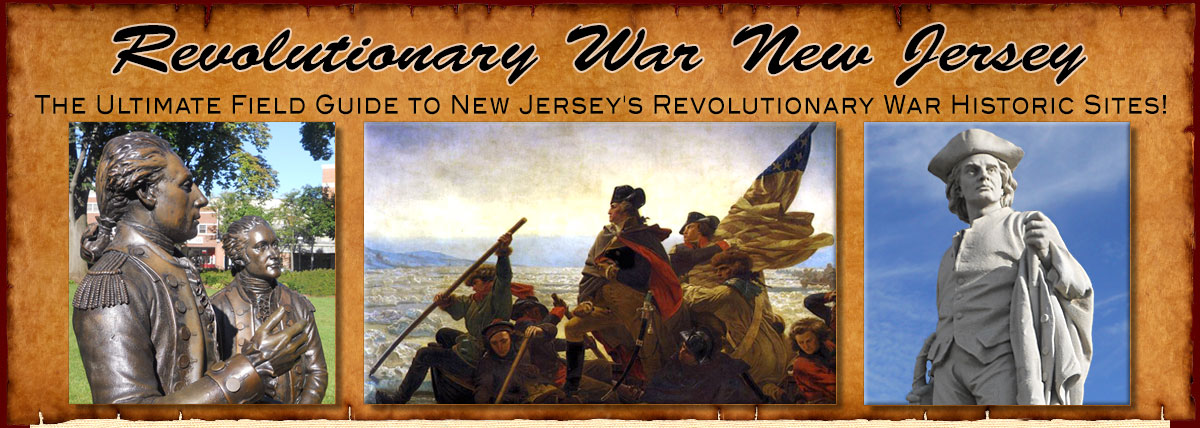

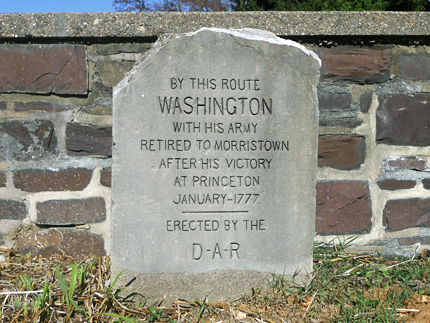
Kingston Presbyterian Church Cemetery
Main St and Church St..
Map / Directions to Washington Route Marker
Map / Directions to all Kingston Revolutionary War Sites
Following their victory at the Battle of Princeton on January 3, 1777, General George Washington and the Continental (American) Army went to Morristown for winter quarters, where they arrived on January 6. This marker, which stands in front of the wall of Kingston Presbyterian Cemetery, is the second of a series of thirteen, showing the route taken by Washington's army from Princeton to Morristown. [1] It was at this site during their journey that an important decision was made. (See "Conference on Horseback" below. )
The other twelve markers in this series can be found in Princeton, Griggstown, Bridgewater, Somerville, Bedminster, Bernardsville, Basking Ridge, Harding Township and Morris Township. For a map tracing the route of all thirteen markers from Princeton to Morristown, click here.
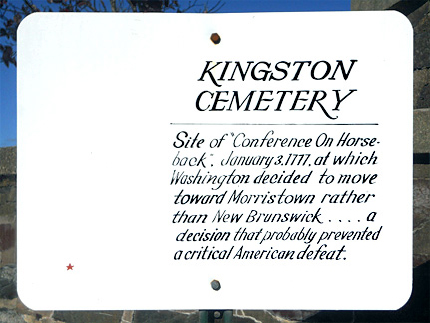
In 1777 at this location, the road from Princeton divided in two: one path went to New Brunswick and the other went north towards to Morristown. It was at this site during the army's journey from Princeton to Morristown, that Washington held a conference with his officers where a critical decision was made.
Following the victory at Princeton, Washington had considered attacking the British troops at New Brunswick. However, due to the tired condition of his troops, who had fought in battles at Trenton and Princeton over the previous couple of days, Washington decided to move the army to Morristown for winter quarters rather than make an attack on New Brunswick.[2]
General Washington explained the decision to head to Morristown in a letter to Congress written two days later: [3]
"My original plan, when I set out from Trenton, was, to push on to Brunswic[k]; but the harassed state of our troops, many of them having had no rest for two nights and a day, and the danger of losing the advantage we had gained by aiming at too much, induced me, by the advice of my officers, to relinquish the attempt."
A year and a half later, the Continental Army would pass through Kingston again in another important march. In June 1778, the Continental Army were marching across New Jersey in pursuit of British troops who had abandoned their occupation of Philadelphia and were making their way to New York City. On June 25, the Continental Army reached Kingston, and they encamped here for the night. Three days later, the two armies would meet at Monmouth Courthouse (Freehold) and fight the Battle of Monmouth.
There are no historic sites in Kingston associated with that 1778 encampment. However, historic sites associated with the Continental Army's June 1778 march and the Battle of Monmouth can be found in Lambertville, Mount Airy, Hopewell, Englishtown, Freehold, and Manalapan. [4]
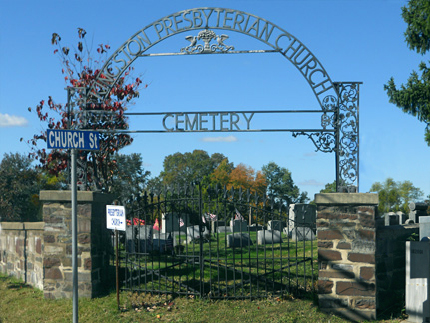
The Cemetery
Revolutionary War soldiers are buried in this cemetery: [5]
William Bastedo
Died November 10, 1843 - Age 89
Jochem Gulick
Captain - 3rd Regiment, NJ Militia
September 27, 1724 - December 26, 1803
John Gulick
Major in NJ Militia
June 14, 1753 - September 11, 1828
Aaron Longstreet
Died May 25, 1829 - Age 87
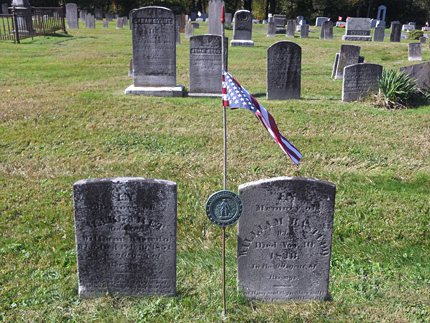
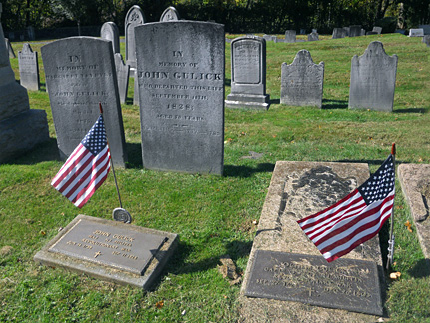

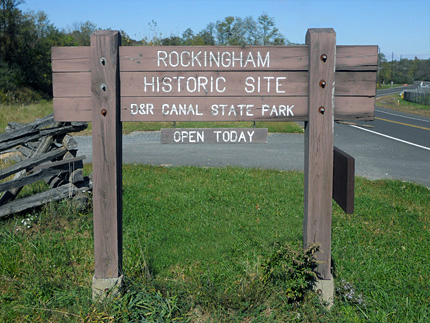
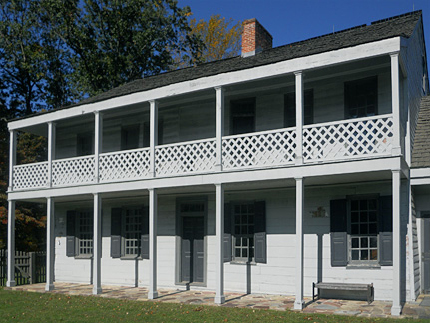
Rockingham Historic Site
84 Laurel Ave.
(Parking entrance on Kingston Rocky Hill Rd.)
Map / Directions to Rockingham
Map / Directions to all Kingston Revolutionary War Sites
For information about tours and upcoming events, see the Rockingham Historic Site website
Rockingham was General Washington's final military headquarters of the Revolutionary War. He stayed at this house from August 23 to November 10, 1783. It was during this time, on September 3, that the Treaty of Paris was signed, officially ending the Revolutionary War. Due to the slowness of Atlantic Ocean travel in the 1780's, it took almost two months for the news to reach America. It was at Rockingham, on October 31, 1783, that Washington received the news that the Treaty of Paris had been signed and the war was officially over. Congress was at that time meeting in Nassau Hall in Princeton, when they received the news the same day. I consider it only fitting that after New Jersey's significant role in the Revolutionary War, both General Washington and Congress were in New Jersey at the time they received this momentous news!
During Washington's stay at Rockingham, he entertained such visitors as James Madison, Elias Boudinot, Thomas Paine, and Annis Stockton, the widow of Declaration of Independence signer, Richard Stockton. George Washington's wife Martha stayed with him for part of his time at Rockingham, although in early October she returned to Mount Vernon, the Washingtons' home in Virginia. Washington wrote his Farewell Address to the Armies of the United States while at Rockingham on November 2, 1783.
Rockingham, which was also known as Berrien Mansion, was built circa 1710 and enlarged in the 1760's. It is believed to be the second oldest house in the Millstone River Valley. The house was originally located about a mile north-northeast from its current location. It has been moved three times: in 1896, in 1957, and finally in July 2001 to its current site, as part of the Delaware and Raritan Canal State Park. [6]

1. ^ This marker was erected by the Daughters of the American Revolution.
• For more details and accompanying source notes about the Battle of Princeton and the 1777 Morristown encampment, see the Princeton and Morristown pages of this website.
2. ^ David Hackett Fischer, Washington's Crossing (New York: Oxford University Press, 2004) p. 341
3. ^ George Washington letter to the President of Congress, sent from Pluckemin, January 5, 1777. Reprinted in:
George Washington; Edited by Jared Sparks, The Writings of George Washington Volume 4 (Boston: Russel, Odiorne and Metcalf; and Hilliard, Gray, and Co., 1834) pages 258-261(This specific quote appears towards the end of the letter, on page 261)
Available to be read at Google Books here4. ^ The following papers of George Washington are marked as Kingston June 25, 1778:
“General Orders, 25 June 1778,” Founders Online, National Archives (http://founders.archives.gov/documents/Washington/03-15-02-0565 [last update: 2015-06-29]). Source: The Papers of George Washington, Revolutionary War Series, vol. 15, May–June 1778, ed. Edward G. Lengel. Charlottesville: University of Virginia Press, 2006, p. 536.
▸ Note the quote from James McHenry diary which mentions the "hault [sic] at Kingston".“From George Washington to Major General Philemon Dickinson, 25 June 1778,” Founders Online, National Archives (http://founders.archives.gov/documents/Washington/03-15-02-0566 [last update: 2015-06-29]). Source: The Papers of George Washington, Revolutionary War Series, vol. 15, May–June 1778, ed. Edward G. Lengel. Charlottesville: University of Virginia Press, 2006, pp. 536–537.
“From George Washington to Major General Lafayette, 25 June 1778,” Founders Online, National Archives (http://founders.archives.gov/documents/Washington/03-15-02-0571 [last update: 2015-06-29]). Source: The Papers of George Washington, Revolutionary War Series, vol. 15, May–June 1778, ed. Edward G. Lengel. Charlottesville: University of Virginia Press, 2006, p. 539.
• For more information and accompanying source notes about the locations on this march, see the Lambertville, Mount Airy, Hopewell, Englishtown, Freehold, and Manalapan pages of this website.
5. ^ Names, dates, and military information drawn from gravestones and markers in the cemetery.
6. ^ The information about Rockingham, Washington's stay here, and the three moves of the house was drawn from the Rockingham State Historic Site's website.